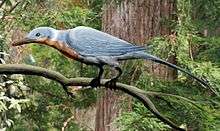Shanweiniao
| Shanweiniao Temporal range: Early Cretaceous, 122 Ma | |
|---|---|
 | |
| Life restoration | |
| Scientific classification | |
| Kingdom: | Animalia |
| Phylum: | Chordata |
| Class: | Reptilia |
| Clade: | Dinosauria |
| Order: | Saurischia |
| Suborder: | Theropoda |
| Clade: | †Enantiornithes |
| Family: | †Longipterygidae |
| Genus: | †Shanweiniao O'Connor et al., 2009 |
| Species: | †S. cooperorum |
| Binomial name | |
| Shanweiniao cooperorum O'Connor et al., 2009 | |
Shanweiniao is a genus of long-snouted enantiornithine birds from Early Cretaceous China. One species is known, Shanweiniao cooperorum. There is one known fossil, a slab and counterslab. The fossil is in the collection of the Dalian Natural History Museum, and has accession number DNHM D1878/1 and DNHM1878/2. It was collected from the Lower Cretaceous Dawangzhngzi Bed, middle Yixian Formation, from Lingyuan in the Liaoning Province, China.
O'Connor et al. (2010) found that Shanweiniao is a close relative of Longipteryx, Longirostravis, and Rapaxavis,[1] which together form a clade of long-beaked enantiornithine birds.
The genus name Shanweiniao means "fan-tailed bird" in Chinese. The authors report that Shanweiniao is the only known enantiornithine bird with a tail surface capable of generating lift, as in modern birds. They also report that only one other Mesozoic bird, Yixianornis grabaui, which is a basal ornithurine, has been reported with this fan - shaped tail feather morphology.
The species name, cooperorum, is after Carl and Lynn Cooper who donated funds to support the study of Mesozoic birds in China.[2]
References
- ↑ O'Connor, J.K.; Gao, K.-Q.; Chiappe, L.M. (2010). "A new ornithuromorph (Aves: Ornithothoraces) bird from the Jehol Group indicative of higher-level diversity" (PDF). Journal of Vertebrate Paleontology. 30 (2): 311–321. doi:10.1080/02724631003617498.
- ↑ Jingmai K. O'Connor; Xuri Wang; Luis M. Chiappe; Chunling Gao; Qingjin Meng; Xiaodong Cheng & Jinyuan Liu (2009). "Phylogenetic Support for a Specialized Clade of Cretaceous Enantiornithine Birds with Information from a New Species". Journal of Vertebrate Paleontology. 29 (1): 188–204. doi:10.1671/039.029.0121.